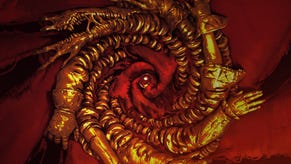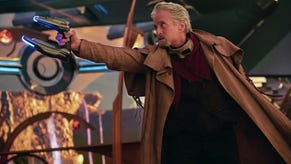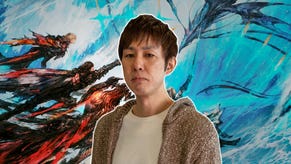Final Fantasy VI, the Essence of a Franchise Distilled for SNES
Though perhaps not the best of the series, FFVI was definitely the most Final Fantasy-ish of the lot.
This article first appeared on USgamer, a partner publication of VG247. Some content, such as this article, has been migrated to VG247 for posterity after USgamer's closure - but it has not been edited or further vetted by the VG247 team.
Originally published Feb. 2014
If Lightning Returns represents Final Fantasy taken to its weirdest extreme, you need simply turn the clock back 20 years and find its calm center: 1994's Final Fantasy VI. (Or, for those of you still living in the Super NES era, Final Fantasy III.)
Everything that defines the name "Final Fantasy" is present and accounted for in FFVI. It has an epic, driving, central story; a mad villain with a mindless urge to destroy for destruction's sake; a highly flexible skill system; a huge cast of diverse characters; immense player freedom within the constraints of the Japanese RPG design model; extraordinary graphics and music; and elaborate story set pieces that far surpass anything seen in its contemporaries.
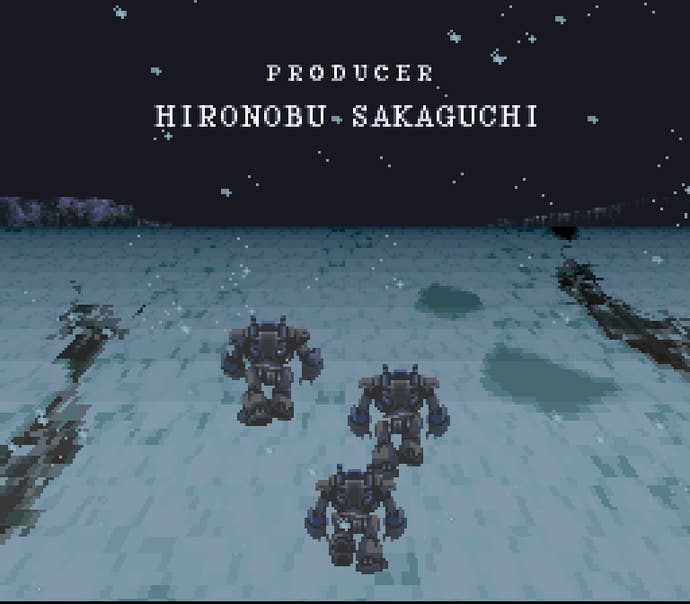
It also embodies Final Fantasy's flaws. The epic plot wanders all over the place; the flexibility of the skill system turns the entire adventure into a total cake walk; few of the dozen or so party members demonstrate any real depth of characterization; the linear and open-ended portions of the quest are segregated awkwardly into separate halves of the game; and... well, actually the graphics and music are still pretty great, but you'd never know from playing the hideous mobile port or scratchy Game Boy Advance remake.
No, FFVI isn't the best Final Fantasy. It doesn't have the best story, the most ambitious presentation, the deepest mechanics, the most liberating structure, or the best-defined cast. Yet it does all of those things well -- not simply with competence, but with panache. It's the most well-rounded entry of the series, comfortable with itself and willing to push against the boundaries of technology without getting lost in spectacle. How many other RPGs would be willing to stop everything for 15 minutes so that players could take part in an opera followed by a battle in the rafters with a comic relief villain trying to drop a five-ton weight on the lead actress? And how many would then follow up such cartoon inanity a few hours later by shattering the planet with a world-ending apocalypse, leaving behind a land so bleak that monsters die on their own in combat and the heroine attempts suicide?

FFVI felt even more remarkable for U.S. gamers, because console RPGs were still such a rarity in the '90s. Only a tiny fraction of games Japan began churning out in the wake of Dragon Quest made it stateside; Final Fantasy, for which we'd seen fully half the entries to date in English by 1994 (along with a bunch of Game Boy games from other series rebranded as "Final Fantasy" for the west), was one of the least stranded. Yet even then, we'd missed out on the meaty, mechanics-driven Final Fantasy V, a game whose Job system (among other things) provided valuable context for the workings of FFVI.
Speaking as someone who had dabbled in RPGs prior to 1994 but never really committed to the genre due to its complexity and lack of visual appeal, FFVI offered me an essential breakthrough. The game was about as pretty as a massive tile-based adventure crammed into a tiny Super NES cartridge could manage. And the splendor kicked in from the opening moments, which saw a trio of robot-riding warriors marching across a snowy field as the lights of a distant mining town rose over the horizon. In combat, those same armored suits could unleash a flurry of vivid spell effects and mechanical strikes. It all looked like the Final Fantasy that had already trickled its way into the U.S., but amped up to new levels.
Meanwhile, the workings of the game struck a perfect balance between expansive freedom and explanatory progression. After getting a taste of those Magitek suits' powers, things settled down considerably; you began building a fresh party from scratch, and while each character had his or her own special skill -- thieving, special tool attacks, nullifying elemental attacks, and more -- only a handful of characters could wield magic. By the time spells became available to the entire party, combat had settled into a steady groove. Every new factor arrived in its own time, carefully meted out to ease the player into the essentially systems without ever overwhelming.

You didn't have to know the conventions of Final Fantasy to enjoy and complete FFVI; it was sufficiently self-explanatory to be approachable even for someone who didn't particularly get the importance of things like min-maxing stats through Magicite junctions. In fact, I completed the game without even realizing summons existed, somehow blundering my way to victory. On subsequent playthroughs, however, I discovered an abundance of content and systems hiding beneath the surface, enough to encourage experimentation and alternate strategies that kept the game from growing stale with repeated play.
Final Fantasy VI aimed to be the summation of all that had come before for Final Fantasy while pushing the series into new territory. It tweaked the active-time battle system with a variety of surprising mechanics; some worked, like Sabin's Street Fighter-inspired special moves, while others didn't, especially Cyan's sword techniques that prevented players from executing any other move while they charged up. It made the summoned beasts ("Espers") an integral element of the game, yet it downplayed the standard summoned attacks in favor of creating a bond between characters and Espers that would shape each individual warrior's traits. Meanwhile, it was the first Final Fantasy to discard the concept of Crystals altogether, and classical fantasy races were gone as well. There was something akin to continuity at work in the series: The elves and dwarves that played such prominent roles in the original Final Fantasy had faded over the course of its sequels, and FFV saw the Crystals shatter forever. FFVI left those concepts behind to explore new ideas.
In hindsight, FFVI seems closest in spirit to Final Fantasy VII, minus all those "integrated movie" ambitions. It combined the class-based Job mechanics of FFV while attempting to give players even more freedom to customize their party, eventually stripping down the barriers between individuals to let you define your team as you like. Want to turn Sabin the monk into a mage? Or use speedy Locke the thief as a knight? FFVI was fine with that. Nearly all of FFV's class mechanics found form in FFVI (even esoteric ones like Geomancer and Berserker), and the character-specific skills led to interesting strategies and situations -- pile-driving an undead railroad engine into oblivion, for instance -- but in no way were players locked into those roles for their team.
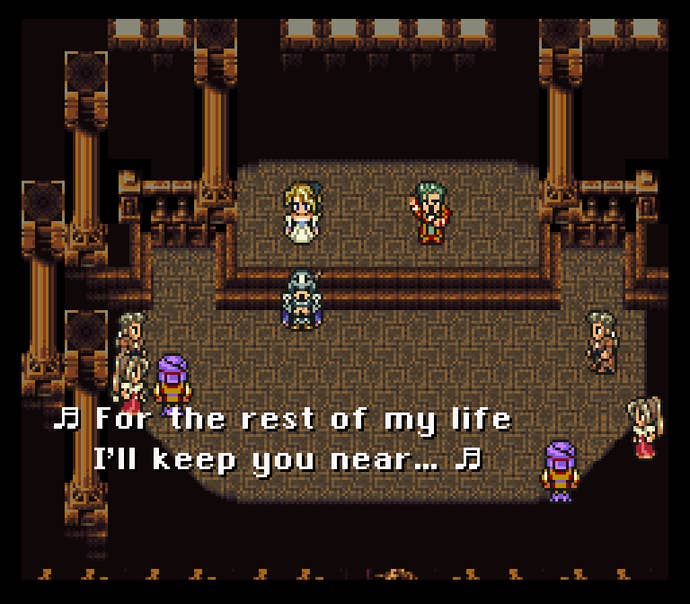
If the essence of role-playing games boils down to player choice, FFVI represented a brilliant expression of the genre. No, choice didn't come in the form of narrative; the game's story shook out the same way no matter how you played it. It's how you got there -- the way you built your characters, the order in which you tackled the freeform events of the second half, the limitations you imposed on yourself for fun -- that kept FFVI so interesting. The game was crammed with detail, with options, and with secrets. It was the sort of RPG that players obsessed over for years in such numbers that obscure glitches and Easter eggs have earned their own names and inspired entire guides. It was the kind of game that gives you seemingly useless gear so that you could turn a debilitating status ailment into an advantage, should the notion occur to you. It was a playground for the dedicated fan, and a gateway drug for newcomers.
It's easy to lament the fact that they don't make Final Fantasy games like this anymore, but that's not really fair; no one makes any games like this, period. Like The Misadventures of Tron Bonne, Final Fantasy VI is the product of a different era. In 1994, you could create a game with top-of-the-line graphics, totally accessible play, impressive mechanical depth, and enormous scope without needing to sell 10 million units just to break even. The same modest technology and presentation that made it possible for story to go from Ultros the octopus attempting a Looney Tunes plot to Celes the runic knight attempting suicide also made it possible for developers to go hog-wild and create any kind of RPG they wanted. The irony of Lightning Returns is that it actually tries to do a lot of the same things people love in FFVI, but it falls flat because of progress. Mood whiplash between the silly and the dead serious undermines the narrative when rendered with realistic characters rather than chubby cartoon sprites, and the realities of HD development render top-end graphics a luxury for a handful of top-selling brands that dare not stray from a successful formula. Cherish games like FFVI; they don't make 'em like this anymore because they can't.





